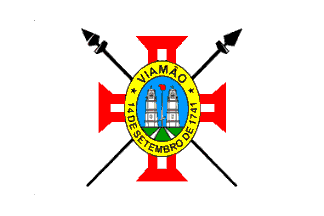 image by Joseph McMillan
image by Joseph McMillan
Last modified: 2012-02-11 by ian macdonald
Keywords: rio grande do sul | viamao | cross: order of christ | spears: 2 (black) |
Links: FOTW homepage |
search |
disclaimer and copyright |
write us |
mirrors
The flag is white with a red cross of the Order of Christ
superimposed on two black spears in saltire, and overall an oval showing two towers flanking
a liberty pole, surrounded by the name and founding date of Viamão on a yellow
oval ring.
Source:
www.rsviamao.com.br
Joseph McMillan, 17 March 2003
The municipality of Viamão (239,234 inhabitants; 1,494 sq. km) is located
25 km east of Porto Alegre.
Viamão emerged in 1741 as a settlement
founded around a chapel by Francisco Carvalho da Cunha. In 1752, the first
immigrants from the Azores Islands landed in Itapúa and colonized the area.
As an early nucleus of colonization, Viamão is the source of the settlement
of Porto Alegre, Santo Amaro, Triunfo, Rio Pardo, Taquari and the towns of
the northern coast of Rio Grande do Sul. In 1763, the Spanish invasion
prompted the transfer of the State capital from Rio Grande to Viamão; the
capital was eventually transferred to Porto Alegre in 1773. In 1808, Viamão
seceded from Porto Alegre as an independent municipality.
The origin
of the name of Viamão is disputed. Some say that five tributaries of river
Guaíba - Jacuí, Caí, Gravataí, Taquari and Sinos - form a palmed hand, Viamão
therefore meaning "Vi a mão", "I have seen a hand". Other say that Viamão
comes from "ibiamon", "Ibis land". Yet another explication alludes to a road
("via") between hills ("monte"). Finally, Viamão could also be related to the
former name of the Guimaraes province in Portugal, Viamara.
http://www.viamao.rs.gov.br/a-cidade/historia - Municipal website
On
the coat of arms of Viamão, the oval shield recalls the arms of the Rio
Grande Republic, which Viamão supported under the name of Vila Setembrina.
The golden border of the shield represents the increase in wealth of the
settlement thanks to cattle-breeding, and includes the date of erection of
the first chapel dedicated to Our Lady of the Conception, the patron saint of
the Royal House of Portugal. The blue field represents the religious feelings
of the first colonists and the aforementioned chapel, represented by the two
towers, around which the settlement grew up. The white saber [placed
vertically in the middle of the shield] recall the proclamation of the Rio
Grande Republic on 11 September 1836, as well as the camps and the trenches
of the revolutionaries set up near Lomba da Tarumã. The green base represents
the fields, the profusion of new land and the triumph of the pioneers The two
white stripes symbolize the primitive paths used by the early cattle breeders
to access their domains. The two crossed black spears symbolize the virtue of
the warriors and freemen who have developed Viamão's domains. The Cross of
Christ, which was shown on the seals of Pedro Álvares Cabral's ships, recalls
the remote history of the colonization from Portugal and the Azores. Red
represents audacity, while white represents integrity.
http://www.viamao.rs.gov.br/a-cidade/brasao-e-bandeira - Municipal website
Ivan Sache, 14 January 2012